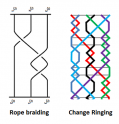Three is a general purpose interest of embodied minds
As indicated by Burkard Polster (The Mathematics of Juggling [excerpt], Monash University, 2003), the diagram above-right shows what the trajectories of juggling the basic 3-ball pattern look like (viewed from above). The three trajectories form the most basic braid. Braids are recognized as important mathematical objects. It has been shown that every braid can be juggled in that sense (Polster, 2003; Matthew Macauley, Braids and Juggling Patterns, 2003; Satyan Devadoss and John Mugno, Juggling braids and links, The Mathematical Intelligencer, 29, 2007). The implications have been further discussed separately (Potential cognitive implications of toroidal helical movement, 2016; Category juggling reframed through visualization dynamics, 2016).
And again, let’s remember Tony Judge‘s reason for his interest in juggling and braiding in the first place:
“juggling” is widely used as a metaphor to describe the challenge of responding to conflicting priorities in governance
Judge has eighteen bibliographic supports for that assertion, including:
**
Noting the correspondence between juggling — a circus-performer’s art — and braiding — not quite knitting, not quite knotting, and don’t those two words fit well together — an art associated with the decoration of hair and ribbons — I wondered whether there might not be a musical analog in counterpoint, and posted my inquiry on Twitter using this diagram of braiding:

**
I was fortunate: Change-ringing, surely very speedily responded to my inquiry:
Change-ringing, surely
The art of change-ringing in British churches and among hand-bell ringers is indeed the classic example of highly constrained and patterned musical counterpoint, so I happily Googled away in search of a change-ringing pattern comparable to my braiding patternc[left side, below], and came across the pattern [right side] in a page on the Cambridge Surprise Minor changes:

Just Knecht, too, had some interesting observations & questions..
**
Metaphor, analogy, parallelism — these are avenues into the creative process in general, and threeness analogies and metaphors interrupt our usual binary cognitive processing in a way that enhances our capacity to comprehend complexity.
I’m therefore offering this post to Ali Minai and Mike Sellers, in the hope that it will serve as a provocation to their already advanced thinking about systems dynamics. Tony Judge, obviously enough, it’s also a tribute to you…
Previous posts of mine with threeness as a topic include
Page 2 of 3 | Previous page | Next page